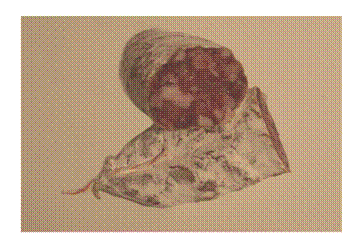Dry fermented sausage
Salt, nitrite, pH and temperature all control fermentation, as well as the safety and quality of dry fermented meat products. Traditionally salt has been used in very high quantities in fermented sausages because of its influence on the taste and its role in microbiological stability; but more importantly, salt is an essential constituent of dry fermented products because of its role in the fermentation process itself.
Figure 4.1 French fermented sausage

On account of the traditional recipes used for these products, there are not so many studies on salt reduction. What is more, the studies that have been carried out have not been successful in reducing salt in substantial amounts while maintaining the traditional characteristics of the products (Muguerza et al., 2004).
The main approaches explored and their results are as follows.
- Reduced salt
The lower salt limit found for a good quality salami-type fermented sausage is 2.5% NaCl; once it is lowered to 2.25% the sausages are less firm and the yield lower than with higher salt content (Ruusunen et al., 2005).
- Partial sodium replacement with other salts
Partial replacement by salts such as potassium, magnesium and calcium as well as phosphates has been examined in different combinations.
- Sodium content was partly decreased (from 2.6% to 1%) and partly replaced with a mixture of potassium (0.55%), magnesium (0.23%) and calcium (0.46%). A decrease in nitroso haem pigments was found in the final product. However, reduced firmness was found, which was expected given that the chloride ions were replaced with ascorbate ions, which do not react effectively with meat microfilaments. In addition, sensory acceptability was lower mainly due to the less salty taste (Gimeno et al., 1998).
- Potassium chloride, potassium lactate and glycine were used, in different combinations, as sodium chloride substitutes. An important flavour defect was found with substitutions greater than 40% for each of the three substitutes: bitterness with KCl substitution, sweet taste with glycine and a lactate flavour with K-lactate. Additionally, a loss in cohesion was detected when NaCl was replaced by potassium lactate at levels higher than 30% or by glycine at levels higher than 50% (Gou et al., 1996).